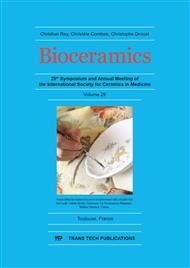p.97
p.105
p.113
p.120
p.126
p.132
p.138
p.145
p.150
Development of Controllable Simvastatin-Releasing PLGA/β-TCP Composite Microspheres Sintered Scaffolds as Synthetic Bone Substitutes
Abstract:
The bone remodeling process plays an essential part of the calcium homeostatic system and provides a crucial mechanism for adaptation to physical stress, the repair of damaged bone and the removal of old bone. We reported previously that sustainable release of simvastatin (SIM) from poly (lactic-co-glycolic acid) (PLGA) formulations could induce bone formation. The aim of this study was to develop a simvastatin-releasing PLGA/β-TCP composite microspheres (β-SPMs) sintered scaffolds (β-SPMSS) as a synthetic bone substitute, and investigate the influence of the dissolution medium on the drug release capabilities of these device based on a physicochemical model for bone remodeling. X-ray diffraction analysis (XRD) results showed β-TCP and SIM could be encapsulated into the PLGA microspheres. The β-SPMs and the β-SPMSS were able to produce sustained release of SIM for 1 month in simulated body fluid (SBF), whereas these composites released SIM for 10 days in acetate buffer (AB). The release rate of SIM from β-SPMSS in AB was faster than in SBF, indicating that the β-SPMSS could control drug release with bone cells activity response, and could be used as a scaffold in bone remodeling area. These results suggested that the β-SPMSS could release SIM sustainably, with bone cells activity response, and could be used as a scaffold in bone remodeling area.
Info:
Periodical:
Pages:
126-131
Citation:
Online since:
November 2017
Authors:
Keywords:
Price:
Сopyright:
© 2017 Trans Tech Publications Ltd. All Rights Reserved
Share:
Citation:


